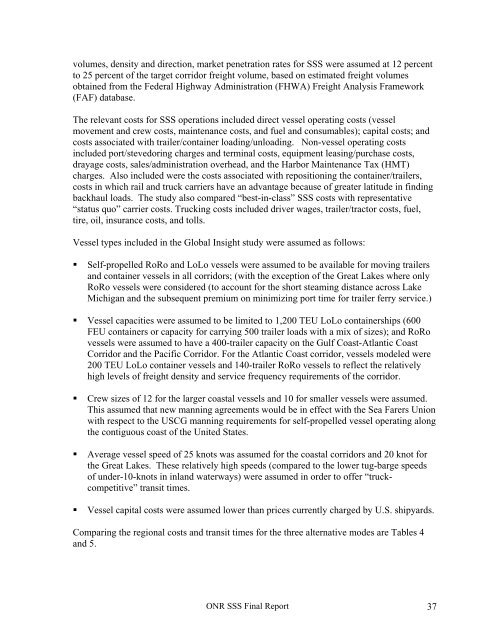Office of Naval Research - National Transportation Library
Office of Naval Research - National Transportation Library
Office of Naval Research - National Transportation Library
You also want an ePaper? Increase the reach of your titles
YUMPU automatically turns print PDFs into web optimized ePapers that Google loves.
volumes, density and direction, market penetration rates for SSS were assumed at 12 percentto 25 percent <strong>of</strong> the target corridor freight volume, based on estimated freight volumesobtained from the Federal Highway Administration (FHWA) Freight Analysis Framework(FAF) database.The relevant costs for SSS operations included direct vessel operating costs (vesselmovement and crew costs, maintenance costs, and fuel and consumables); capital costs; andcosts associated with trailer/container loading/unloading. Non-vessel operating costsincluded port/stevedoring charges and terminal costs, equipment leasing/purchase costs,drayage costs, sales/administration overhead, and the Harbor Maintenance Tax (HMT)charges. Also included were the costs associated with repositioning the container/trailers,costs in which rail and truck carriers have an advantage because <strong>of</strong> greater latitude in findingbackhaul loads. The study also compared “best-in-class” SSS costs with representative“status quo” carrier costs. Trucking costs included driver wages, trailer/tractor costs, fuel,tire, oil, insurance costs, and tolls.Vessel types included in the Global Insight study were assumed as follows:• Self-propelled RoRo and LoLo vessels were assumed to be available for moving trailersand container vessels in all corridors; (with the exception <strong>of</strong> the Great Lakes where onlyRoRo vessels were considered (to account for the short steaming distance across LakeMichigan and the subsequent premium on minimizing port time for trailer ferry service.)• Vessel capacities were assumed to be limited to 1,200 TEU LoLo containerships (600FEU containers or capacity for carrying 500 trailer loads with a mix <strong>of</strong> sizes); and RoRovessels were assumed to have a 400-trailer capacity on the Gulf Coast-Atlantic CoastCorridor and the Pacific Corridor. For the Atlantic Coast corridor, vessels modeled were200 TEU LoLo container vessels and 140-trailer RoRo vessels to reflect the relativelyhigh levels <strong>of</strong> freight density and service frequency requirements <strong>of</strong> the corridor.• Crew sizes <strong>of</strong> 12 for the larger coastal vessels and 10 for smaller vessels were assumed.This assumed that new manning agreements would be in effect with the Sea Farers Unionwith respect to the USCG manning requirements for self-propelled vessel operating alongthe contiguous coast <strong>of</strong> the United States.• Average vessel speed <strong>of</strong> 25 knots was assumed for the coastal corridors and 20 knot forthe Great Lakes. These relatively high speeds (compared to the lower tug-barge speeds<strong>of</strong> under-10-knots in inland waterways) were assumed in order to <strong>of</strong>fer “truckcompetitive”transit times.• Vessel capital costs were assumed lower than prices currently charged by U.S. shipyards.Comparing the regional costs and transit times for the three alternative modes are Tables 4and 5.ONR SSS Final Report 37
















